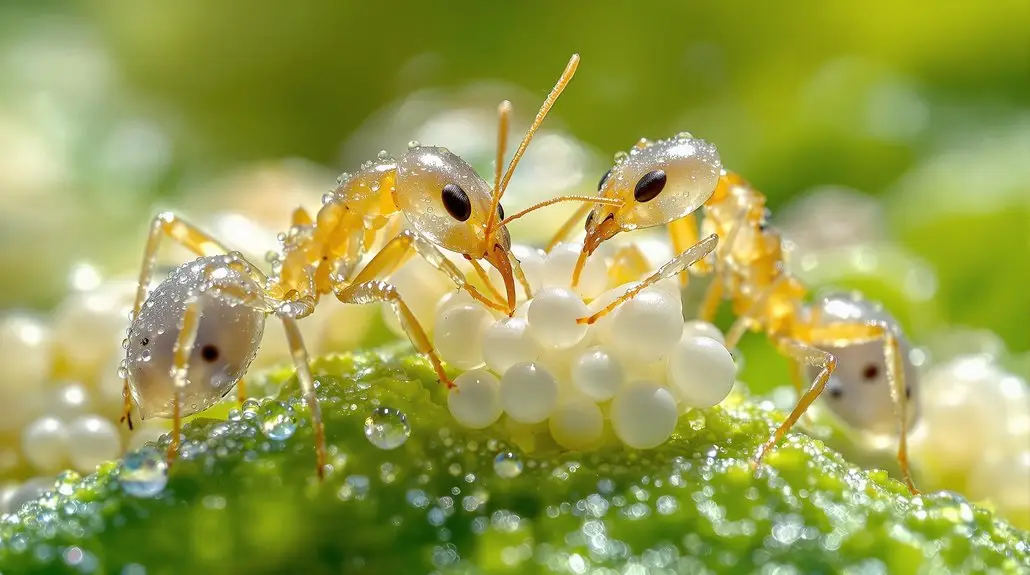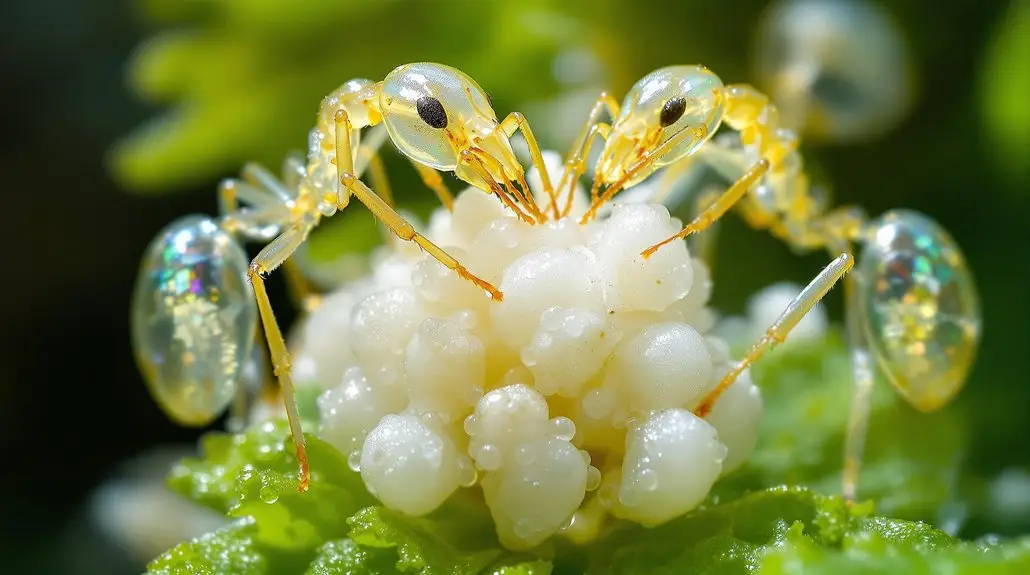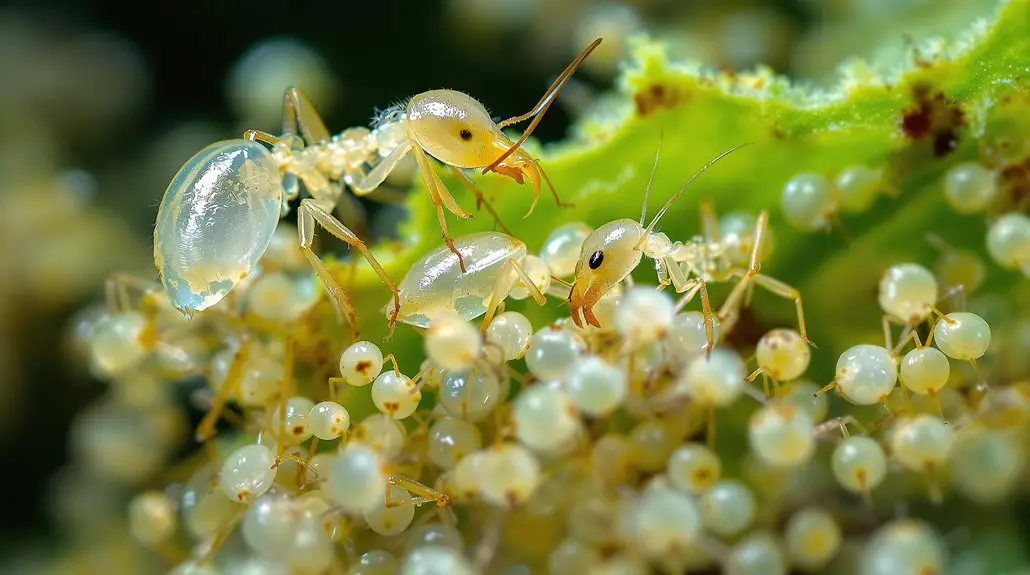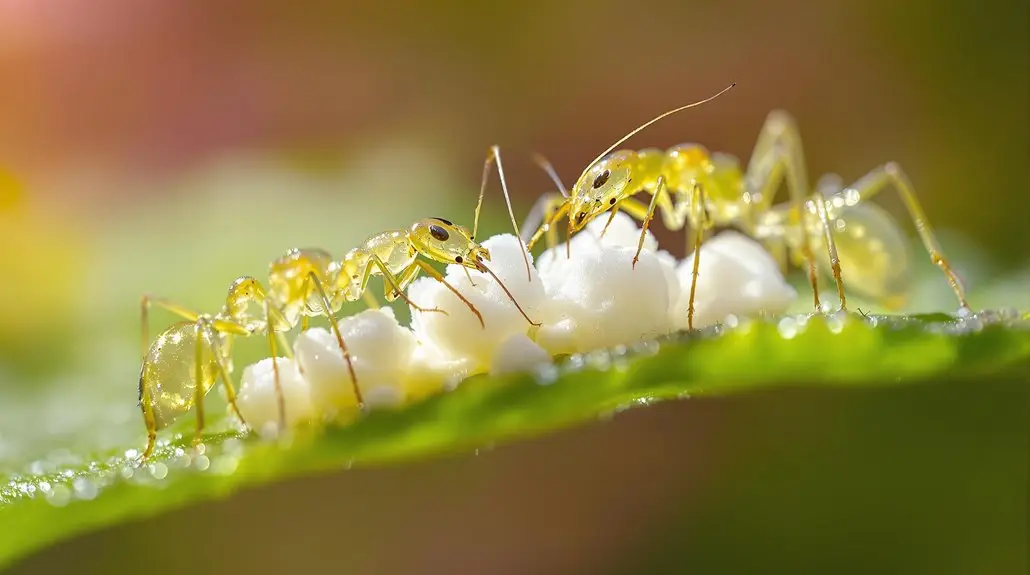The interactions between ghost ants (*Tapinoma melanocephalum*) and invasive mealybugs (*Phenacoccus solenopsis*) illustrate a mutualistic relationship where ghost ants protect mealybugs from natural enemies in Florida, such as lady beetles and parasitoids. In return, ghost ants benefit from the nutrient-rich honeydew produced by mealybugs, which aids in their colony growth. However, this relationship disrupts natural predator behavior, diminishing the effectiveness of biological control and leading to increased mealybug populations and crop damage. Understanding these dynamics is essential for addressing the broader ecological implications and developing effective management strategies to mitigate their impact on agriculture and ecosystems. Insights await you.
Key Insights About Ghost Ants and Invasive Mealybugs
- Ghost ants provide protection to mealybugs from predators, enhancing their survival and reproduction rates in agricultural settings.
- The honeydew produced by mealybugs serves as a food source for ghost ants, promoting their colony growth.
- Ghost ants disrupt natural predator behavior, leading to decreased effectiveness of biological control against mealybug populations.
- The mutualism between ghost ants and mealybugs results in significant crop damage, complicating pest management strategies.
- Future research should investigate the ecological impacts of ghost ant and mealybug interactions on local ecosystems and agricultural systems.
Mutualistic Relationship Overview

In the fascinating world of ecology, the mutualistic relationship between ghost ants and mealybugs showcases a remarkable partnership where both species benefit. Ghost ants, scientifically known as Tapinoma melanocephalum, actively tend to mealybugs, specifically Phenacoccus solenopsis, providing protection from various natural enemies. This protection is vital, particularly when predators like lady beetle larvae and parasitoid wasps threaten mealybug survival. By reducing the impact of these natural enemies, ghost ants enable mealybugs to complete their life cycles more effectively, thereby increasing their populations.
As a result of this relationship, mealybugs produce honeydew, a nutrient-rich secretion that ghost ants consume, consequently enhancing their colony growth. This exchange of resources exemplifies the dynamics of mutualism, where both organisms thrive. The presence of ghost ants alters the behavior of natural enemies, causing them to avoid areas occupied by these ants, which further secures mealybug populations. Additionally, the effectiveness of biological control agents can be greatly hindered in environments dominated by ant-mealybug mutualism due to the protective behavior of ghost ants. Furthermore, eco-friendly pest control strategies may need to consider the impacts of such mutualistic relationships to effectively manage pest populations.
However, the ecological consequences of this relationship extend beyond individual benefits. In regions where ghost ants are prevalent, their protective role can disrupt natural pest control mechanisms, diminishing the effectiveness of biological control agents.
This disruption can lead to the establishment and spread of invasive mealybug populations, complicating pest management strategies. Understanding this intricate relationship is essential for developing effective integrated pest management approaches, highlighting the need to take into account both species in ecological studies and agricultural practices.
Benefits to Ghost Ants
The mutualistic relationship between ghost ants and mealybugs brings significant advantages to the ants themselves. Primarily, ghost ants benefit from the honeydew produced by mealybugs, which serves as an important food source that greatly enhances colony growth compared to other options like mealworms. Research indicates that colonies exposed to high-density mealybug treatments exhibit a marked increase in mass, underscoring the nutritional value of this relationship.
Additionally, the consumption of honeydew is amplified in warmer temperatures, further promoting colony health. Moreover, ghost ants actively tend to mealybugs, which not only boosts their survival rates but also increases honeydew excretion. This caretaking behavior directly correlates with improved growth and stability within ant colonies. Ghost ants are highly adaptable, as they can occupy multiple nesting sites, enhancing their foraging efficiency and resource access.
Ghost ants also possess defense mechanisms, employing alarm signals from their pygidial glands to protect their nests during aggressive encounters, ensuring colony security. The presence of ghost ants plays a significant role in defending mealybugs from natural predators, such as lady beetle larvae, thereby securing a steady food supply.
Their aggressive behavior, especially under elevated temperatures, enhances this protective role, allowing them to effectively reduce predation pressure. Additionally, ghost ants adapt well to various nesting environments, both indoors and outdoors, which contributes to their overall survival and ecological resilience.
Benefits to Mealybugs

While mealybugs thrive in various environments, their relationship with ghost ants greatly enhances their survival and reproduction. This mutualistic interaction offers several advantages to mealybugs, markedly improving their ability to flourish in competitive ecosystems.
By relying on ghost ants for protection, mealybugs experience increased survival rates, as ghost ants actively defend them against natural predators such as lady beetles and parasitoids. Effective pest control is crucial in managing the populations of these invasive species.
Here are three key benefits mealybugs gain from their relationship with ghost ants:
- Enhanced Survival: Ghost ants reduce the impact of natural enemies by defending mealybugs, leading to fewer instances of predation and parasitism. This protection allows mealybugs to thrive in areas where they might otherwise be decimated.
- Improved Reproduction: The presence of ghost ants promotes earlier maturation and increased lifespan in mealybugs. By mitigating threats from predators, ghost ants indirectly support higher fecundity, allowing mealybug populations to grow more rapidly.
- Favorable Environmental Conditions: Ghost ants help create a more stable environment for mealybugs by reducing the risk of fungal infections, which can negatively affect their health and reproduction. Additionally, this relationship enhances the survival of mealybugs in new habitats, showcasing the importance of mutualistic relationships in invasive species dynamics.
This mutualistic relationship not only provides mealybugs with a steady supply of honeydew but also guarantees that they experience less stress from competing organisms.
Impact on Natural Predators
Interactions between ghost ants and their natural predators greatly alter predation dynamics, favoring mealybugs and impacting the effectiveness of various predators.
For instance, lady beetles, including both adults and larvae of Cheilomenes sexmaculata, tend to avoid areas inhabited by ghost ants. This avoidance greatly reduces the fecundity of lady beetle adults, leading to fewer eggs being laid and a decreased hatch rate for those eggs in the presence of ghost ants. Consequently, lady beetle larvae become less effective in controlling mealybug populations, further tilting the balance in favor of mealybugs.
Moreover, mealybug parasitoids, such as Aenasius bambawalei, also exhibit strong avoidance responses to ghost ants. Their performance declines sharply when ghost ants tend to mealybugs, as the ants provide a protective barrier that diminishes the parasitoids’ success in parasitizing mealybugs. This species is often associated with human activities, which further increases its interactions with both pests and their natural enemies.
This protective behavior not only increases the survival of mealybugs but also undermines the effectiveness of natural predators, further enabling the mealybug population to thrive.
Global Distribution Patterns

When examining the global distribution patterns of ghost ants, you’ll find that these invasive species thrive in tropical and subtropical regions, impacting agricultural ecosystems worldwide. Their ability to spread rapidly through human activities, such as shipping and travel, allows them to establish populations in diverse environments, from the Caribbean islands to temperate climates like Florida and Hawaii. This widespread presence raises concerns about their potential effects on local flora and fauna, as well as agricultural practices in the areas they invade. Notably, ghost ants have been identified as one of the top three key pest species in Florida, underscoring their significant economic impact. Additionally, their interactions with other pests, such as rodents and fleas, can exacerbate pest control challenges in invaded areas.
Invasive Species Spread
The spread of the ghost ant, *Tapinoma melanocephalum*, illustrates the complex dynamics of invasive species and their global distribution patterns. Originally from the Old World tropics, this ant species has adapted well to various environments, effectively occupying disturbed habitats near human settlements.
You’ll find ghost ants thriving in both tropical and subtropical regions, often establishing themselves in homes, restaurants, and hospitals, as well as in natural reserves. Their ability to relocate nests quickly enables them to colonize new areas rapidly.
Key factors contributing to the spread of ghost ants include:
- Human Activities: These ants are frequently introduced through cargo, luggage, and horticulture, which facilitate their global movement.
- Habitat Flexibility: They can live in diverse environments, from soil and fallen trees to indoor spaces, allowing for widespread adaptation.
- Geographical Reach: Ghost ants are present in various locations, including Brazil, Miami, and even remote areas like the Galapagos Islands, showcasing their potential for further spread. Understanding these dynamics is essential for managing invasive species and mitigating their impacts on native ecosystems. Moreover, insights into global patterns of IAS invasion can inform effective interventions and management strategies.
Global Agricultural Impact
Global agricultural systems face significant challenges due to the spread of mealybugs, particularly *Phenacoccus solenopsis*. This pest has established a presence in over 24 countries, inflicting considerable damage on crops, especially in Asia and Australia, where its suitable habitats thrive.
In countries like China, India, and Brazil, *P. solenopsis* contributes to severe yield losses, with estimates suggesting a 30-40% reduction in cotton production alone in India. The total potential area for invasion spans approximately 12,690,522 km², with a notable 22% classified as highly suitable for the pest’s proliferation.
Environmental factors play a vital role in this distribution, as rising temperatures, driven by climate change, create more favorable conditions for *P. solenopsis*. Research indicates that by 2050, the area deemed suitable for this pest could increase by 15%, with significant expansions in regions across Asia, Europe, and North America. Additionally, the pest’s presence is expected to threaten biodiversity as it disrupts local ecosystems.
Consequently, agricultural stakeholders must remain vigilant, as the ongoing expansion of *P. solenopsis* poses a persistent threat, potentially leading to widespread economic impacts on global agriculture and food security. Understanding these patterns is essential for developing effective management strategies.
Ecological Consequences
When you consider the interactions between ghost ants and mealybugs, you’ll notice significant ecological consequences, particularly regarding mealybug populations and the effectiveness of their natural enemies.
The presence of ghost ants tends to boost mealybug survival and reproduction, especially when predators like lady beetle larvae are around, leading to higher mealybug densities on infested plants. This dynamic illustrates how ghost ants act as a protective agent for mealybugs against their natural enemies, allowing these pests to proliferate even in the presence of predators.
In turn, this mutualism undermines the role of natural enemies, as ghost ants reduce their efficacy, allowing mealybugs to thrive unchecked and potentially causing considerable damage to plant health.
Increased Mealybug Populations
Increased populations of mealybugs, fueled by their symbiotic relationship with ghost ants, can lead to serious ecological consequences. The presence of ghost ants greatly enhances mealybug survival on plants, especially when natural enemies, like lady beetle larvae, are nearby. This protection results in a much higher number of mealybugs thriving on plants with ghost ants compared to those without.
Moreover, the mutualism benefits both species; high-density mealybugs provide an essential food source—honeydew—for ghost ants, which facilitates their colony growth. This dynamic can lead to increased mealybug populations, further intensifying their ecological impact. Ghost ants are known for forming large colonies with multiple queens, which can exacerbate the situation by increasing their protective presence over mealybugs.
Consider the following ecological consequences:
- Crop Damage: Areas with ghost ants and mealybugs, such as cotton fields in India and Pakistan, experience substantial crop damage due to the increased mealybug populations.
- Invasive Species Promotion: The relationship between ghost ants and mealybugs may support the invasion success of both species, disrupting local ecosystems.
- Increased Pest Management Challenges: As populations rise, managing these pests becomes more challenging, particularly in agricultural and domestic environments, leading to economic impacts.
Reduced Natural Enemy Effectiveness
The presence of ghost ants markedly undermines the effectiveness of natural enemies that typically help control mealybug populations. These ants, particularly Tapinoma melanocephalum, rarely attack the predators and parasitoids of mealybugs, such as lady beetles (_Cheilomenes sexmaculata_) and parasitoids like _Aenasius bambawalei_. Their chemical secretions, derived from pygidial glands, deter these natural enemies, leading to avoidance behaviors that considerably reduce lady beetle egg-laying in areas occupied by ghost ants.
Furthermore, ghost ants tend to mealybugs, thereby increasing their survival rates while diminishing the impact of natural enemies through protective behaviors, including alarm systems that fend off potential predators.
This interaction disrupts the natural balance in ecosystems, allowing mealybug populations to thrive unchecked, which can lead to increased plant damage and the spread of diseases, including viral and fungal infections.
Studies have shown that ghost ants effectively protect mealybugs, altering the dynamics of local species and contributing to ecological disruptions. Consequently, understanding these interactions is essential for developing effective pest management strategies, as the presence of ghost ants complicates the role of natural enemies within agricultural and urban environments.
Biological Characteristics

Biological characteristics play an essential role in understanding the interactions between ghost ants and mealybugs. Tapinoma melanocephalum, commonly known as ghost ants, display a life cycle that includes four larval instars and a development period ranging from 16 to 52 days. Queens can lay an impressive average of 5.3 eggs daily, with multiple queens in a colony contributing to a potential total of 106 eggs per day.
In contrast, the invasive mealybug species, Phenacoccus solenopsis, reproduces primarily through parthenogenesis, producing an average of 334.4 crawlers per female within a reproductive phase of 10 to 47 days. This species has been noted for its significant economic losses to cotton production, particularly in regions like India and China.
Here are three notable biological characteristics of these species:
- Physical Traits: Ghost ants exhibit a bicolored appearance, with a blackish-brown head and thorax and a milky white abdomen, while mealybugs are distinguished by their waxy threads that protect their crawlers and eggs.
- Behavioral Adaptations: Ghost ants modify their diet from carbohydrate-rich to protein-rich when competing with aggressive species like *Solenopsis invicta*, while mealybugs have shown increasing resistance to commonly used insecticides, complicating control efforts.
- Ecological Impact: Ghost ants create nests in concealed locations, promoting the fitness of mealybugs by excluding their natural enemies, thereby enhancing the mealybug’s ability to thrive in various environments.
Understanding these biological characteristics is vital for grasping the dynamics of their interactions.
Management Strategies
Effective management strategies are vital for controlling both ghost ants and mealybugs, as their interactions can worsen infestations. To effectively tackle these pests, you should consider a combination of chemical controls, manual removal, and environmental modifications. For ghost ants, using non-repellent insecticides like Navigator SC or Phantom Aerosol II is essential to guarantee they do not avoid the treatment. Employing baiting methods with slow-acting baits can also help in getting the bait back to the nest. Additionally, treating the nest directly, especially if located outdoors, can greatly reduce their population. Implementing organic pest control methods can also provide a safer alternative for managing these pests.
When managing mealybug infestations, it’s important to prevent transportation between plants by controlling ghost ants. You should also conserve natural enemies of mealybugs, such as lady beetle larvae. Manual removal of mealybugs using alcohol-dipped cotton swabs is effective, as is applying insecticidal soap that won’t harm beneficial insects.
The table below summarizes key management strategies for both pests:
| Strategy | Ghost Ants | Mealybugs |
|---|---|---|
| Chemical Control | Non-repellent insecticides | Insecticidal soap |
| Manual Removal | Baiting with slow-acting baits | Alcohol-dipped swabs |
| Environmental Modifications | Seal cracks and reduce moisture | Remove honeydew sources |
| Natural Enemies | Conserve beneficial insects | Avoid harming natural predators |
| Monitoring | Track ant trails and bait effectiveness | Regular inspection for early detection |
Future Research Directions

Understanding the interactions between ghost ants and mealybugs opens up exciting avenues for future research. As these species continue to thrive in various ecosystems, it’s essential to investigate deeper into their mutualistic relationship and its broader ecological implications. Research can explore several key areas to enhance our understanding and inform management strategies.
- Ecological Impacts: Investigate how temperature variations affect the mutualism and potentially expand the habitat range for both ghost ants and mealybugs. Understanding these dynamics could shed light on their adaptability in changing climates.
- Behavioral Mechanisms: Examine the specific sugars that trigger honeydew preferences in ghost ants, as well as the foraging behaviors in response to varying concentrations of honeydew. This knowledge could provide insights into their feeding strategies and survival tactics.
- Natural Enemy Dynamics: Study how ghost ant tending behaviors influence the survival and behavior of mealybug natural enemies, such as lady beetles and parasitoids. Analyzing these interactions can highlight the role of ghost ants in shaping the community dynamics of these ecosystems.
Frequently Asked Questions
How Do Ghost Ants Find Mealybugs on Plants?
Ghost ants locate mealybugs on plants by utilizing their keen sense of smell to detect the sweet, sticky honeydew excreted by the mealybugs.
As you observe these tiny creatures, you’ll notice them actively foraging among the leaves, following chemical cues that signal the presence of their preferred food source.
Their nesting and foraging behaviors are influenced by plant structure, allowing them to efficiently find and tend to mealybugs, enhancing both species’ survival.
What Environmental Conditions Favor Mealybug Infestations?
Mealybug infestations thrive in warm, humid environments, particularly at temperatures around 25°C, where they can rapidly reproduce.
High humidity levels exceeding 70% greatly enhance their survival rates and promote honeydew production, leading to sooty mold growth.
Additionally, mealybugs prefer protected areas, such as the bark of plants, where they can evade natural predators.
Can Ghost Ants Harm Plants Directly?
Curiously, ghost ants can occupy the root zones of plants, leading to significant root damage.
While they’re not typically harmful, their presence may disrupt soil conditions, causing dehydration and stress to the plant.
Furthermore, by fostering relationships with invasive pests, ghost ants can indirectly contribute to plant harm.
This mutualism reduces the effectiveness of natural predators, ultimately exacerbating the detrimental effects on plant health and growth, making management essential for maintaining plant health.
Are There Any Natural Predators of Ghost Ants?
While ghost ants lack specific natural predators, they may face threats from general insect predators, such as phorid flies and other ant species.
Additionally, parasitoids like Eucharitid wasps can affect ghost ants indirectly by targeting their colonies.
However, the primary concern remains their interactions with invasive species, which can disrupt local ecosystems.
Researchers continue to study these dynamics to better understand ghost ants’ ecological roles and their impact on other organisms within their habitats.
How Do Mealybugs Reproduce and Spread?
You might think mealybugs are shy, but they reproduce prolifically.
Female mealybugs lay up to 200 eggs in a cotton-like pouch, hatching within a week into mobile crawlers. These crawlers seek feeding sites, settling down and secreting a waxy substance as they grow.
With several generations possible in a year, adult females continually reproduce, spreading rapidly and potentially transmitting diseases, highlighting the significant impact of their reproductive strategies on ecosystems.
Final Thoughts About Ghost Ants And Mealybugs
In examining the complex interactions between ghost ants and invasive mealybugs, it’s almost amusing to realize that these seemingly insignificant creatures can dramatically alter ecosystems. While ghost ants benefit from the sugary excretions of mealybugs, the latter gain protection from natural predators, showcasing a mutualism that undermines ecological balance. As researchers explore management strategies and seek to understand the broader impacts of this relationship, it becomes evident that even the smallest players can have outsized effects on our environment.
The Hidden Impact of Tiny Titans Gets Control With NaturePest
The intricate dance between ghost ants and mealybugs serves as a stark reminder of the delicate equilibrium within ecosystems. As these tiny titans continue to shape their surroundings, we must pay attention to their influence and the potential consequences of their interactions.
If you’re in South Florida and struggling with pest issues, it’s time to take action! Trust NaturePest Holistic Pest Control to help you manage these invasive species and protect your environment from their disruptive effects. Contact us today to learn more about effective and sustainable pest management solutions.



